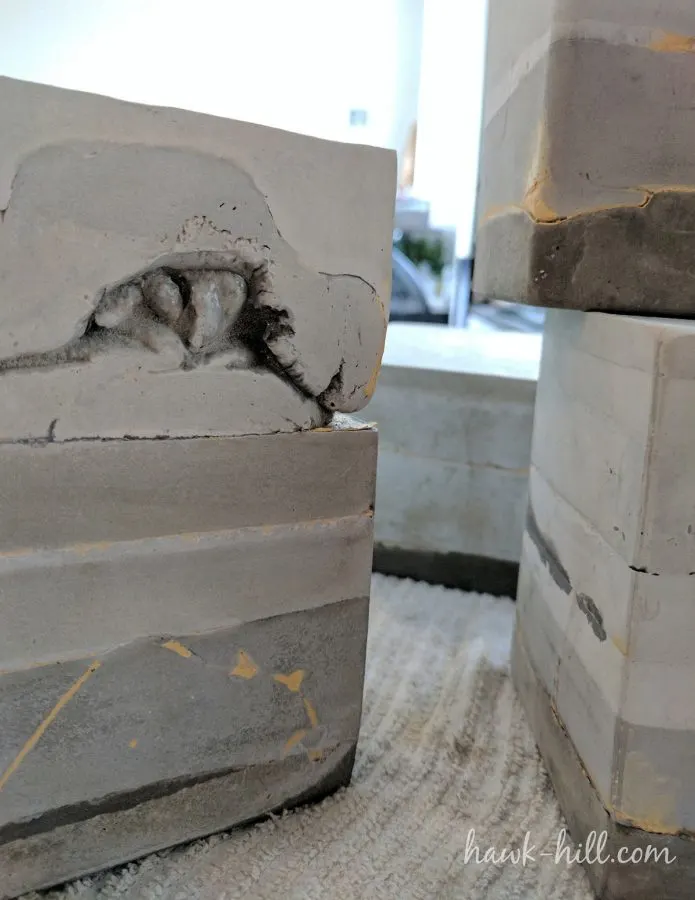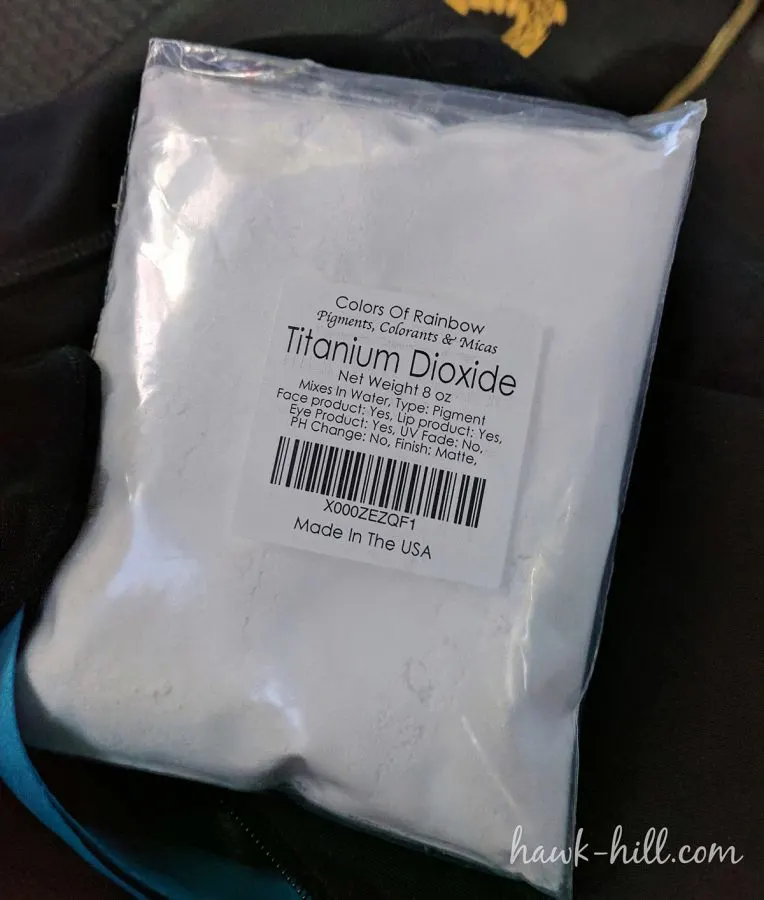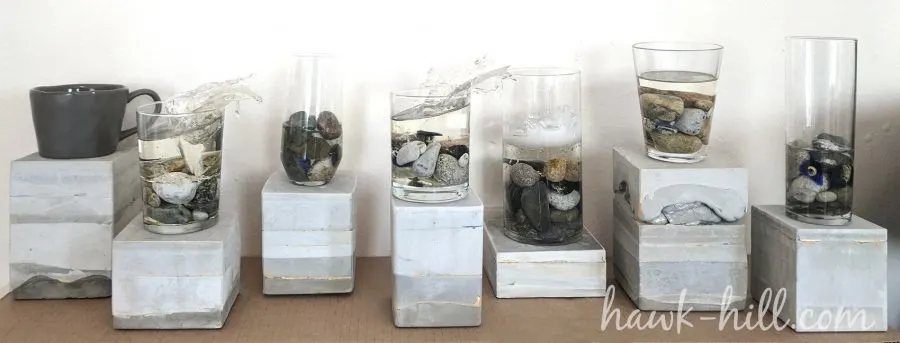DIY cement dye is a tough job. Cement is often a dark media (my favorite crafting variety, Rockite, however, is already light, making dying easier), and the chemical processes and heating that take place during the curing process seem to destroy most dyes.
In my initial attempts, I used a professional grade high pigment fluid acrylic paint and was shocked to find literally no trace of the color after the cement cured. In subsequent attempts I tried alcohol-based dyes and even a super powerful resin pigment, each time un- casting my cement to discover no color visible in the final project.
Finally, after trying all these methods to add color to my cement castings, I found myself at a craft store clutching a grossly overpriced tiny bottle of cement dye and I just couldn’t do it. One more attempt at scouring the internet for cheaper alternatives to achieve dyed concrete turned up an idea to try the dye that hobby soap makers use: pure pigment.
Pigment, dye, and colorant are all words used pretty much interchangeably, but they aren’t the same. While colorant is a word that includes both dyes and pigments, dyes and pigments are not identical. Dyes are colored chemicals that are dissolved in a solution while pigments are colored particles that can be suspended in a liquid but remain distinct structures from that liquid. Consider: a bottle of dye-based stamp ink never settles and separates carrier from coloring, but quality watercolor mixed heavily in water, because it’s pigment-based, will eventually settle at the bottom leaving a clear glass of water.
Making DIY cement dye with pigments
Do pigments work to color concrete? Well, kind of. In my testing, it appears that the pigments made up of larger particles do a much better job of dying concrete.

What didn’t work: Resin dye (made for adding color to clear epoxy resin), Liquitex Basics acrylic paint (a version of paint with a bit more pigment than general craft store paint), craft store paint, and even Liquitex High Flow Acrylic Paints (which are artist-grade, pigment-based, and extremely powerful colors in other media)
The following section may contain affiliate links. As an Amazon Associate, we earn from qualifying purchases.
How I dyed natural colored concrete white
What did work: Raw organic pigment.
While that phrase might sound more like something you would pay a premium price to eat off the salad bar at an organic food market, unprocessed pigment is actually an affordable way to get high quality pigments. They’re the same thing that most commercial concrete dyes are made from, but at a fraction of the price of commercial concrete dye.
Pure Titanium Dioxide* produced dramatic color changes with the addition of one or two tablespoons of powder per pound of cement.


In the image below, you can see how I used this white titanium dioxide pigment to make a DIY cement dye to color the bases for a three-dimensional sculptural art project I made using water glasses and clear epoxy resin sculpted to mimic the look of splashing water.
By mixing the cement in batches, and mixing each batch of cement with different amount of titanium dioxide white pigment, I was able to create gradients, color contrast, and visual interest in my poured cement molds without purchasing commercial cement dye (which is often very expensive or only sold in quantities appropriate for a driveway – not a small art project)

You can confidently use inexpensive titanium dioxide pigment to color fine cement (such as a Rockite) for use in fine art projects as well as home DIY’s (like making your own cement flowerpots and planters or even molding your own industrial concrete countertops)
Just be sure and always create a test batch first. Different cement brands and mixtures are formulated differently and may react with pigments uniquely. Testing is the best way to determine how your DIY cement dye will turn out in your final project. Although I have only tested white, many other pigments are mineral-based and should reliably add drama and color to cement.
Thanks for Reading!!!
I hope you can tell that I love DIY, researching the best affordable solutions for every-day problems opportunities and documenting / sharing solutions!🙌 Hawk-Hill.com is reader-supported.
☕ Hawk-Hill.com is reader-supported. If this article saved you time or money, please consider donating $1 to help me cover the cost of hosting this website OR If you appreciate this information and want to throw a “Thanks!” my way by buying me a coffee – I would Of Course appreciate it! :]
Reader Questions and Recommendations
Readers, do you have any favorite topics / posts? What would you like to read more about in the future? As I hope you can tell from this and other articles on my site, I really enjoy DIY / a good challenge, and I’m not afraid to roll up my sleeves to figure out a great, and hopefully simple 😁 solution. So please feel free to let me know in the comments below (or reach out via social media)!
Ok Really – I’ll try to wrap this up now😂
Finally, if you’d like to continue to learn about interesting DIY options as well as how YOU can tackle creative new projects consider checking out the latest and most popular articles listed on the Hawk-Hill Home Page. I’m always trying to enjoy and write about the creative side of life so please don’t be a stranger – check back often!😍
If you enjoyed this post you may also enjoy reading / perusing / devouring😊 one or all of these articles as well!


keren cormier
Saturday 27th of November 2021
I'm not sure if you have discovered that color you were searching for since posting this but one thing that I surprisingly just recently had pretty bright color results with is the little sample valspar latex paints from lowes. In the satin finish. Didnt take much either but my project wasn't big at all. But for the price it would still definitely be worth it even if you do big ones. And atleast 50 to 60% cheaper than the dyes made for cement. Not to mention the color options is almost any color you can imagine. But just wanted to share this if anyone else needed
Jess
Wednesday 17th of March 2021
Beautiful project! I would love to know if you had to let the concrete dry between your layers when switching up the color. From what I can see it looks like maybe you also layered some gold in there somehow? I would love to hear more about how you did that if you don't mind sharing.
Lindsayanne Brenner
Saturday 20th of March 2021
Great question! Concrete sets pretty quickly (about 10 minutes for it to form a crust, on a project this size) and is very, very dense, allowing layers to be added rapidly. I was able to pour all the layers in the project shown in the space of one afternoon- only leaving a few minutes between batches/layers. Like mixing a cocktail that is meant to have separate liquid layers, pour gently if adding a layer while the layer underneath is wet.
The gold layer is Golden's High Flow Acrylic Paint in Iridescent Gold. I wrote a whole post on creating this appearance of gold veins in cement art! Other than being very messy and highly fluid, it's really easy to add! A squirt on top of a cement layer, then tilted to pool on the edges, creates the appearance of a vein of gold between the concrete "stones".
Patrice Baker
Thursday 7th of January 2021
did you mix the titanium dixoide into the powdered cement, or into the water?
Lindsayanne
Friday 8th of January 2021
Hi Patrice! Thanks for your question! Actually, I can't remember how, specifically, I combined titanium dioxide, water, and cement. Because Rockite is VERY thin when first mixed, I think it probably doesn't matter too much in which order you add the pigmet. As long as you stir well you should get even coloring.